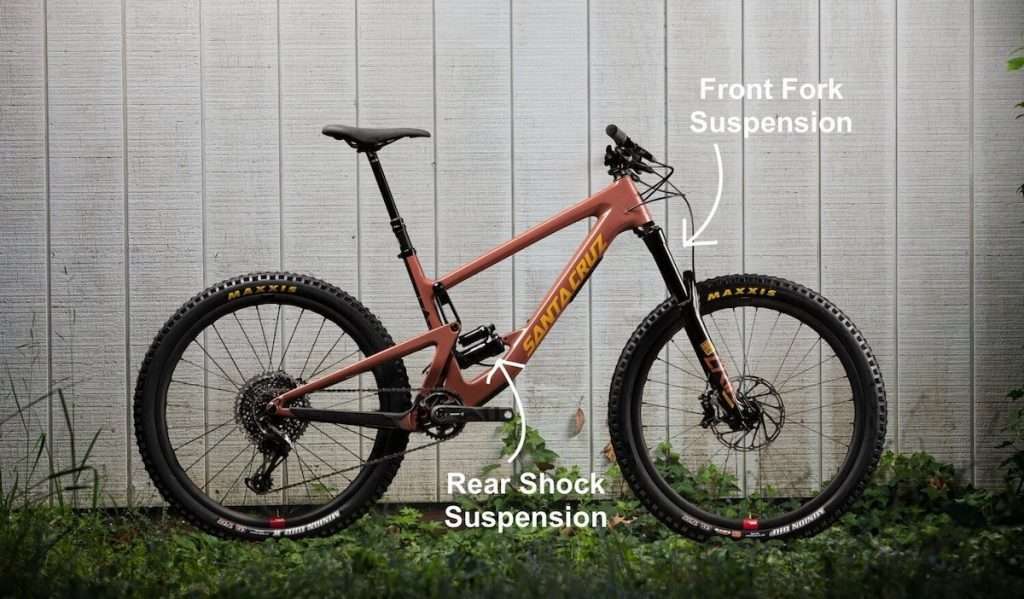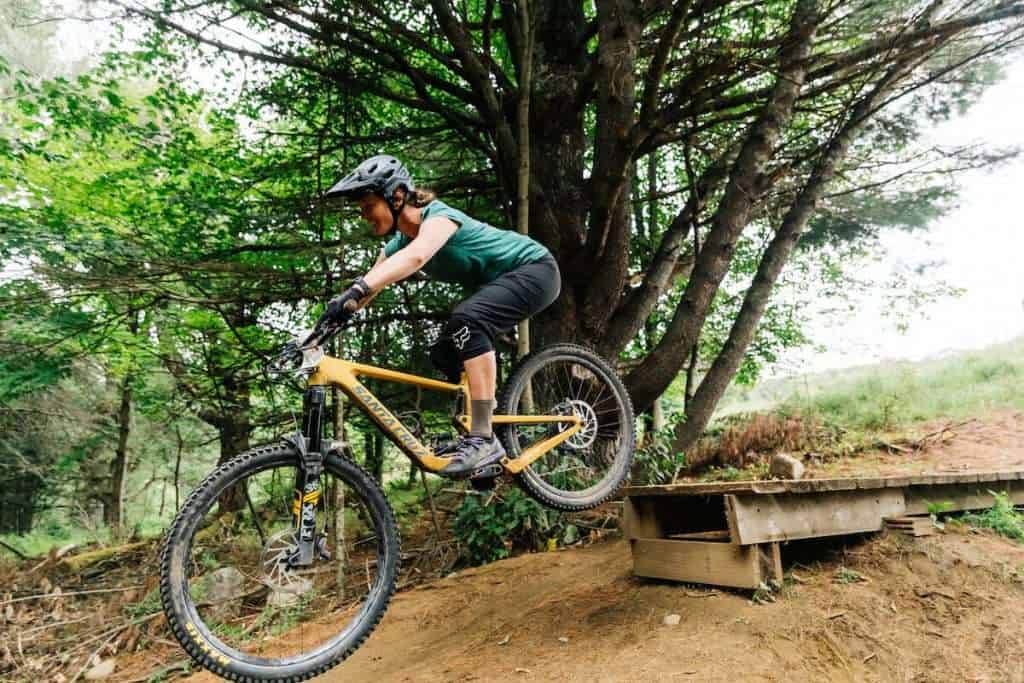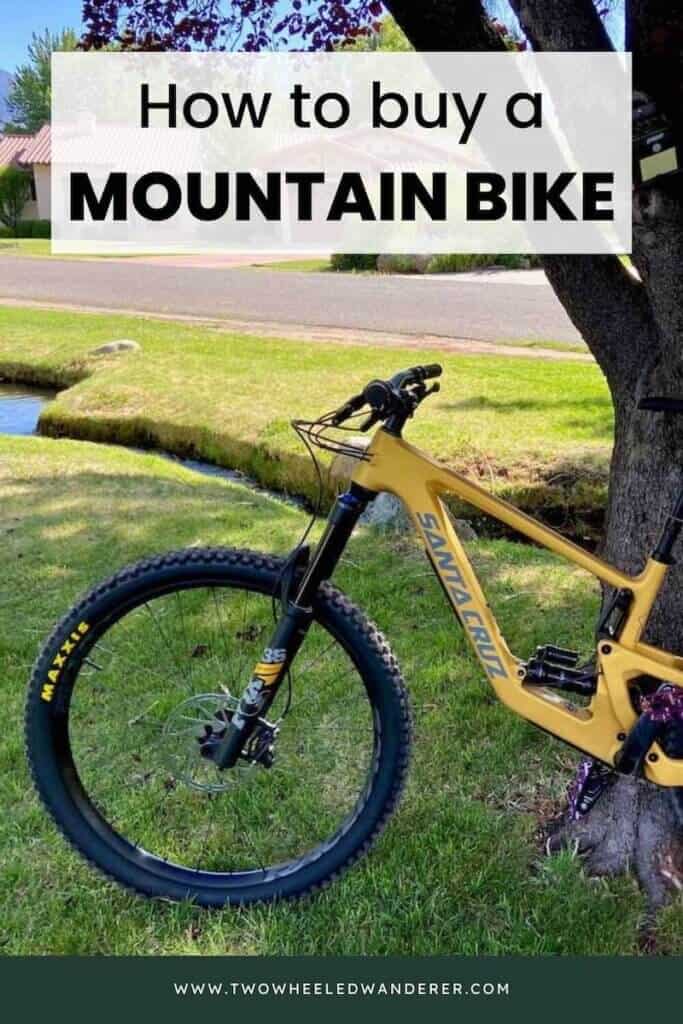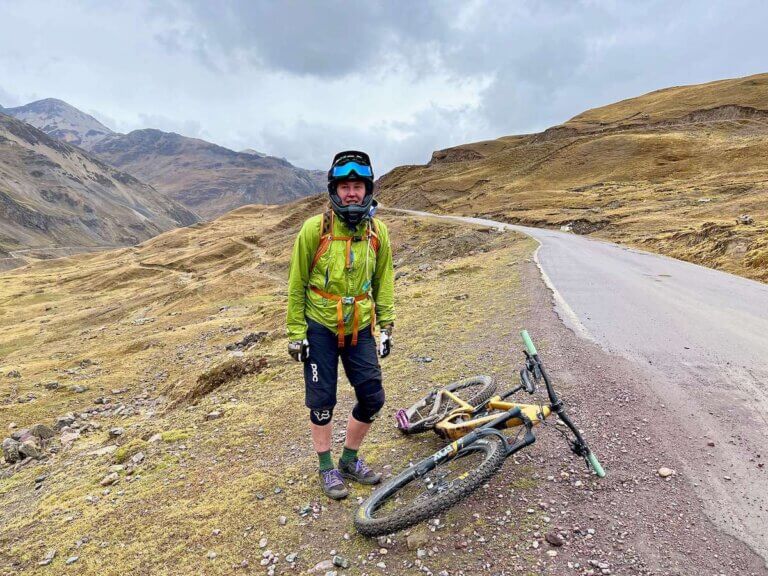How to Buy a Mountain Bike: 7 easy steps
Find the best tips on how to buy a mountain bike including what questions to ask yourself, how to choose a wheel size, where to shop, & more!
Hey there! If you’re reading this, chances are, you’re looking for tips on how to buy a mountain bike. Questions like “how much suspension or travel do I need?”, “what’s a hardtail?”, “which brands are the best?” are all great questions to ask. While I can’t give you an exact answer as to which mountain bike to buy, I can help you answer these questions and more.
This post has everything you need to know about choosing a mountain bike including how to decide on frame material, choosing a wheel size, tips for knowing how much travel you’ll need, etc…
A new (or new to you bike) is a big decision and I want to help you find the perfect fit so that you can have maximum fun out on the trail.
1. Decide if you want a hardtail or a full-suspension mountain bike
If you’re just getting into mountain biking, you might be wondering what the differences are between a hardtail and a full-suspension mountain bike.
A full-suspension mountain bike means that the bike has TWO suspension points: a front shock (the fork) that absorbs movement on the front end and a rear shock that absorbs movement on the backend.

A full-suspension bike (sometimes called ‘full squish’) makes for a smoother, more stable ride along rough terrain. Both the front fork and rear shock work together to absorb bumps and hits along the trail. Without these suspension points, you’d feel a lot more rocks and roots.
Some mountain bikers (mostly cross-country riders) choose to ride a hardtail instead. These bikes only have front suspension, no rear shock. The trade-off is that hardtails tend to be lighter and faster on climbs and pedally sections. But they’re not as good at handling rocky downhill descents, drops, or jumps.

If you’re really looking to get into mountain biking and you want to ride a lot, I highly recommend choosing a full-suspension mountain bike. They do tend to be more expensive, but they’ll also allow you to ride more diverse trails and help you grow your skills as a mountain biker.
2. Determine how much suspension (or travel) you need
Notice how I said how much travel you need, not want. It’s tempting to get the biggest, most bad-ass mountain bike available, but trust me – it’s probably not what you are going to want once you actually start pedaling.
There are four main categories for mountain bikes:
- Short-travel mountain bikes
- Mid-travel mountain bikes
- Long-travel mountain bikes
- Downhill bikes
If you’re just starting out, I recommend choosing a mountain bike in the short to mid-travel category. These bikes are designed to pedal well but can also descend moderate technical terrain and features.
A short-travel mountain bike typically has 100-130mm of rear suspension and a mid-travel mountain bike typically has 140-150mm of rear suspension,
Keep in mind that the more travel/suspension a bike has, the less efficient it will be to pedal.
Read next: 6 Best Beginner Mountain Bikes for New Riders
3. Commit to a wheel size
Modern-day, adult-sized mountain bikes have three wheel-size options: 27.5-inch, 29-inch, and mixed-wheel. There’s no one right answer as to which wheel size you should get. Instead, it’s more about personal preference and what kind of terrain you will be riding.
If you can, try to demo both a 27.5″ bike and a 29-er to get a feel for how each wheel size rides and responds to the trail. Also, note that some mountain bikes only come in 29″ or 27.5″ options while other models you have the option to go either way.
Generally speaking, here are a few tips for determining which wheel size might be best for you:
- If you’re on the shorter side (less than 5’4), 27.5″ wheels may be more comfortable. Some S and XS bikes only come with 27.5″ wheels
- If you’re planning on doing mostly cross-country riding with little to no tech, 29″ wheels are a great option
- If you want to learn how to jump and do a lot of bike park riding, 27.5″ wheels tend to be more playful and responsive. That’s not to say that you can’t jump or ride the bike park with 29″ wheels, though
- If you’re curious about both, you may want to try a mixed wheel (or mullet) bike which has a 29″ wheel in the front and a 27.5″ wheel in the rear. This is what I ride at bike parks or on enduro trails and love it!

4. Research what size bike you need
Most mountain bikes come in standard sizing like XS, S, M, L, XL. Some brands, like Specialized, have their own (weird) sizing, so it’s important to look at size recommendations for each specific brand.
You’ll typically find a size chart on each brand’s website. It’s important to get your sizing right because a bike that is too big or too small can really affect how much fun you have out on the trail.
5. Choose your budget
Brand new full-suspension mountain bikes can range from low $1k’s all the way to $10k+. Mid-range bikes will fall between $3-5,000.
The three main factors that will determine how much you will spend on a mountain bike are:
a) Brand
b) Carbon vs aluminum frames
c) The quality of components like brakes, drivetrain, rear shock, front fork, etc…
Brand
Larger brands typically – but not always – will have more affordable model options compared to smaller ’boutique’ brands. If you’re looking for a budget-friendly option, consider choosing a mountain bike from a larger brand such as Trek, Giant, or Specialized. For a full list of mountain bike brands and price ranges, check out this post.
When narrowing down brands, think about:
- How easy will it be to order new parts? (I broke my Devinci Troy and because they are such a small company on the other side of North America it was a pain to find a dealer that could send me the new parts).
- What is the warranty? (Ideally, carbon frames will come with lifetime warranties).
- What dealer is my local bike shop? (If they are a Trek dealer and you have a Yeti it may be harder for them to do repairs and maintenance).
- What will the resale value be? (Boutique brands like Santa Cruz and Yeti may potentially have a higher resale value than other brands).

Carbon vs aluminum
Carbon vs aluminum frames will also determine the price. Carbon frames are more expensive than aluminum frames. Carbon is lighter, but it can also be damaged more easily by sharp impact (like a rock).
Aluminum, on the other hand, is heavier but can withstand more abuse. If this is your first mountain bike and you’re just getting into the sport, an aluminum bike is a great way to go. You can always upgrade to carbon later.
Components
Lastly, most mountain bike models will come in different price point options. These price points determine the tier of components included with the bike such as brakes, dropper post, drivetrain, cranks, etc…
A more expensive price point will have higher quality components and vice versa. Typically, the mid-level price point tends to be the best value.
For example, Santa Cruz uses the letters D, R, S, X01, etc… to identify their different component group specifications. The D builds are their most basic, low(ish) end models while the X01 AXS are their high-end builds complete with electronic shifting.
What about used bikes?
Buying a used bike can be a great way to get a higher-end bike at a lower price. If you’re interested in shopping for a used bike check out my post on Buying A Used Mountain Bike.
Shopping for a used bike? The Pros Closet has a large inventory of used and professionally serviced bikes
Factory-Direct brands
Some mountain bike brands like Canyon and YT Industries are factory-direct, meaning you can only buy their bikes from their website. This cuts out the middleman and typically allows them to price their bikes at a lower price point.
The downsides to factory-direct brands are that you can’t see or demo the bikes in-person and repairs may need to be done directly by the brand, meaning you have to send the bike or component back to them rather than take it to a local bike shop.
6. Shop around & demo bikes if possible
Once you’ve answered all the questions above, it’s time to start looking for a mountain bike! There are lots of places to shop for mountain bikes and I suggest you start at your local bike shop. This way, you can talk to a professional and potentially even take the bike out for a demo ride. Buying from a local shop will also make it easy to deal with warranties, tune-ups, and any other questions/concerns that come up.
If you don’t have a local shop nearby, there are a number of online retailers that sell mountain bikes as well. A few of my favorites are:
- Mike’s Bikes (they offer 18-month 0% interest financing, which is great if you don’t want to drop a lot of cash in one go)
- Backcountry
- Competitive Cyclist
- Jenson USA
- The Pro’s Closet (for used but professionally serviced bikes)
Demoing a bike
If you can, I highly recommend demoing or renting your top mountain bike choices before pulling the trigger on buying one. This will help you get a feel for how different bikes handle climbs and descents. 27.5″ wheels will feel much different than 29er’s and a short-travel bike (100-130mm) will handle much differently than a mid- or long-travel bike with 140+mm of suspension travel.
Most bike shops have a fleet of rental bikes that you can take out for a day or half a day and most bike parks will also have rental options available.
If you’re really keen on finding the ‘perfect’ bike, you can attend one of the Outerbike events, which usually have dozens of bike brands and models to demo throughout a long weekend. For women, check out ROAM Fest, which also offers tons of mountain bike demo options.

7. Buy pedals
Once you’ve decided on your bike and you’re ready to pull the trigger, the final thing you’ll need to do is buy pedals. Most mountain bikes do not come with pedals because all riders have their personal preferences when it comes to pedal choice. Some ride with flat pedals, others with clipless. Again, it’s a personal preference.
I personally ride with flat pedals while my dad, brother, and sister-in-law are all clipped in. If you go with flats, my favorites are the Chromag Scarab pedals or the Race Face Chester pedals for a more budget-friendly option.

I hope this post gives you a better idea of how to buy a mountain bike. There is no one right answer when it comes to the best bike for you, so it really comes down to what kind of riding you want to do, what your budget is, and your personal preference.
To recap, here are the 7 steps to follow when choosing a mountain bike:
- Decide if you want a hardtail or full-suspension mountain bike
- Determine how much suspension you need
- Commit to a wheel size
- Research bike size
- Choose your budget
- Shop around and demo your top choices if possible
- Buy pedals
Related posts:
- What To Wear Mountain Biking
- Where To Buy Discount Cycling Gear
- Best Beginner Mountain Bikes
- A to Z List of Mountain Bike Brands
What questions do you have about how to buy a mountain bike? What other tips can you add? Leave a comment below!








Amazing guide to buy a good mountain bike. Wanted to know if you have some good mountain bike brands recommendation and how to choose the wheel size for your height.
Honestly, you really can’t go wrong with any bike brands these days. I have a huge post on different bike brands and their pros and cons. That should give you a good start.
As far as wheel size, it’s pretty much personal preference. 27.5″ in front and rear is fading out and now it’s the choice between 29″ front and rear or a mixed wheel bike with a 27.5″ in the back and a 29″ in the front. If you’re just starting out, I’d probably say go with a 29″, but again, it really comes down to personal preference.
Full-suspension mountain bikes alleviate all of the negative impacts of bumps and other discomforts caused by uneven terrain and tough tracks. As a result, your body will be free of fatigue and soreness, allowing you to enjoy the trip more comfortable. It will also encourage you to bike faster and for longer periods of time, allowing you to get the most out of your bicycling experience.
Excellent blog!!! Lots of info and some great advice, specially for beginners looking for answers! “Keep rocking unplug and explore”
Thanks for the kind feedback!